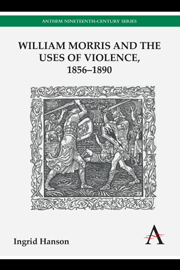Book contents
- Frontmatter
- Contents
- Acknowledgements
- Introduction Warriors Waiting for the Word
- Chapter One The Early Romances and the Transformative Touch of Violence
- Chapter Two Knightly Women and the Imagination of Battle in The Defence of Guenevere, and Other Poems
- Chapter Three Sigurd the Volsung and the Parameters of Manliness
- Chapter Four Crossing the River of Violence: The Germanic Antiwars and the Uncivilized Uses of Work and Play
- Chapter Five ‘All for the Cause’: Fellowship, Sacrifice and Fruitful War
- Afterword ‘Hopeful Strife and Blameless Peace’
- Notes
- Bibliography
- Index
Chapter Three - Sigurd the Volsung and the Parameters of Manliness
Published online by Cambridge University Press: 05 July 2013
- Frontmatter
- Contents
- Acknowledgements
- Introduction Warriors Waiting for the Word
- Chapter One The Early Romances and the Transformative Touch of Violence
- Chapter Two Knightly Women and the Imagination of Battle in The Defence of Guenevere, and Other Poems
- Chapter Three Sigurd the Volsung and the Parameters of Manliness
- Chapter Four Crossing the River of Violence: The Germanic Antiwars and the Uncivilized Uses of Work and Play
- Chapter Five ‘All for the Cause’: Fellowship, Sacrifice and Fruitful War
- Afterword ‘Hopeful Strife and Blameless Peace’
- Notes
- Bibliography
- Index
Summary
In his 1841 essay on ‘The Hero as Divinity’, Carlyle praises the ‘wild bloody valour’ of the ‘Old Norsemen’ and affirms the truth of ‘Odin's creed’, that ‘a man shall and must be valiant; he must march forward, and quit himself like a man, – trusting imperturbably in the appointment and choice of the upper Powers; and, on the whole, not fear at all.’ The conflation of the biblical exhortation to ‘quit you like men, be strong’, and the emphases of Norse mythology on physical courage and destiny offers a potent vision of manliness, a term much used and variously defined in the nineteenth century. It is an idea that is closely linked to violence: the developing discourse of manliness across the nineteenth century entails a variety of shifts in understanding of the meanings and uses of violence, from the anxieties about its place in middle-class life early in the Victorian period to what John Tosh describes as ‘the validation of violence’ that accompanied imperialism later in the century. Morris's engagement with the idea of violence also shifts across the century, but retains always a commitment to this Carlylean vision of the imaginative, if not actual, possibilities of ‘wild, bloody valour’ as a sign of vigour, health and the ‘manliness’ that underpins them both.
- Type
- Chapter
- Information
- William Morris and the Uses of Violence, 1856–1890 , pp. 65 - 96Publisher: Anthem PressPrint publication year: 2013

